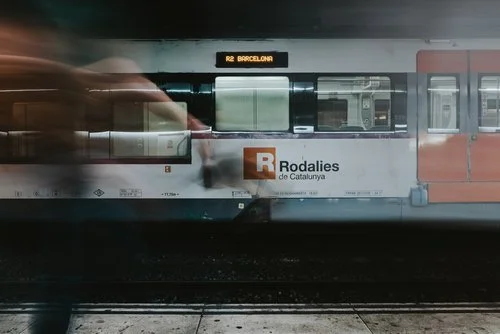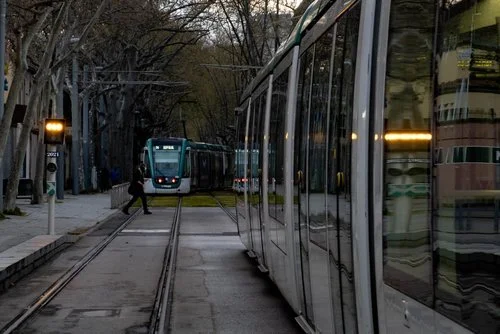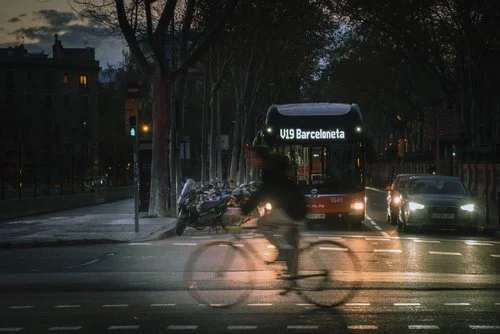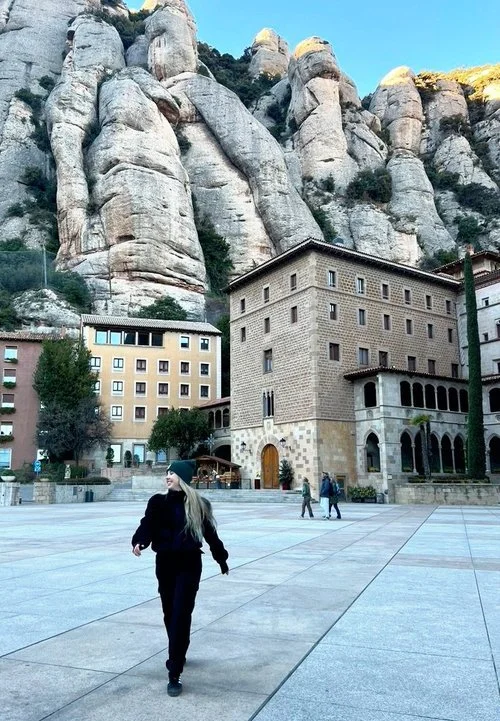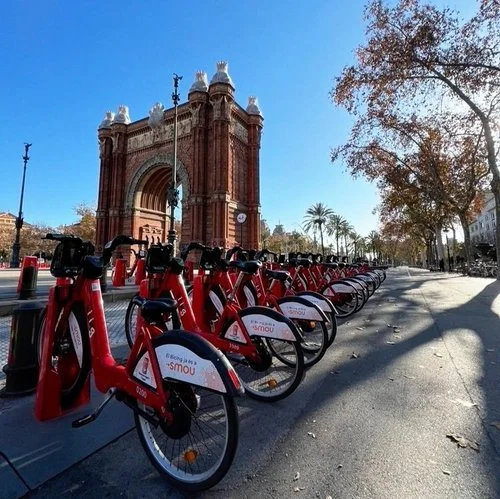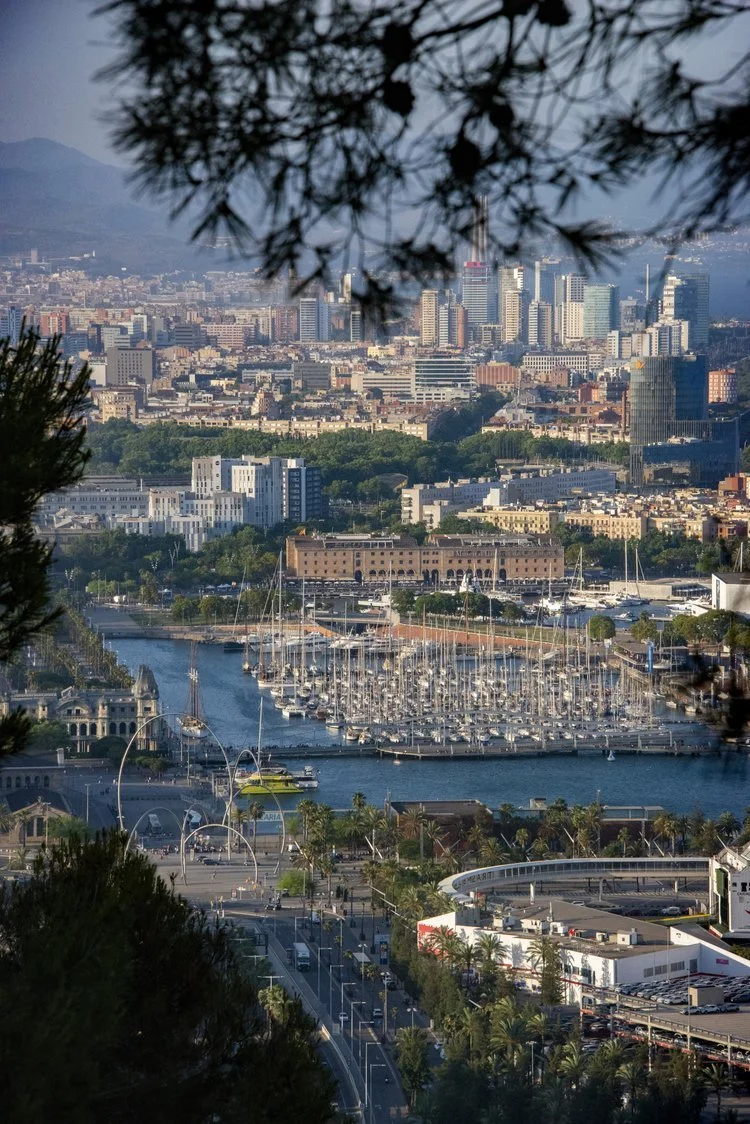Getting Around Barcelona: Transport Tips
Now that you have completed the initial steps, it’s time to start planning your itinerary. With so many incredible attractions to visit, delectable tapas to savour and idyllic beach days to enjoy, it’s understandable that you may feel overwhelmed. However, fear not! This guide will help you navigate the city’s transportation options so that you can explore all that Barcelona offers with ease and confidence. Here’s everything you need to know about Getting Around Barcelona.
Here’s what we cover in this guide:
Metro, Trams & FGC
Bus
Walking
Bicycles
Taxis
How to Get to Barcelona Airport
FAQs
Metro, Trams and FGC
We will deeply dive into all the details to help you navigate Barcelona’s public transport system like a pro. The metro, tram, funicular, and FGC (Ferrocarrils de la Generalitat) are generally the quickest and most convenient ways of getting around BCN.
If you’re looking for an affordable and practical option for transportation in Barcelona, consider using the simple and inexpensive tickets and travel cards available. These networks offer connections between significant attractions and other popular destinations outside the city. Here’s everything you need to know about public transportation in Barcelona:
Metro
Barcelona’s metro network is easily the most accessible and efficient option. Regarding frequency and schedules, the suburban rail service runs far more often than buses and trams. Better yet, you can transfer from one train to another on most routes using the same ticket. So is the metro in Barcelona easy to use? With eight metro lines etched throughout the city, making your way around is made simple thanks to the bold colours and numbers used. Identify your route L1 (red), L2 (lilac), L3 (green), L4 (yellow), L5 (blue), L9N and L9S (orange), L10N and L10S (light blue), L11 (light green) and get on your way. If you’re stumped on how to use public transport in Barcelona, you can also use this metro map for visual reference.
Time Schedule:
Metro (TMB): Weekdays (Monday to Thursday, Sunday and public holidays): 5 am to midnight
Fridays (& evenings before public holidays): 5 am to 2 am
Saturdays: continuous service
Tram
An accessible alternative to the metro is the tram network in Barcelona. If you’re planning to explore this metropolitan city's bustling shopping districts and residential areas, this mode of transportation is both speedy and comfortable.
The two major tram lines in Barcelona are Trambaix T1, T2, and T3 (covers a route from Plaça Francesc Macià, L’Hospitalet de Llobregat, Sant Just Desvern, Sant Joan Despí, Sant Feliu de Llobregat and Cornellà, and the Trambesòs T4, T5, T6 (runs from Olympic Village, Plaça de les Glòries to Sant Adrià de Besòs via the Forum and Badalona).
Time Schedule:
Weekdays (Monday to Thursday, Sunday and public holidays): 5 am to midnight
Fridays, Saturdays (& evenings before public holidays): 5 am to 2 am
Funicular
Catch a unique glimpse over bustling Barcelona with the funicular railway. Situated at the foot of the Parallel metro station (L2 & L3), this option connects Montjuïc Park with the rest of this captivating city. Getting to the top of Montjuic’s bustling hills and lush gardens has never been easier with this transportation option that takes only two minutes. It’s fast and convenient.
Travelling with the metro and funicular is made hassle-free thanks to integrated passes and multi-journey travel tickets.
Time Schedule:
In Autumn & Winter: Weekdays (Monday to Friday): 7.30 am to 8 pm. Saturdays, Sundays (& public holidays): 9 am to 8 pm.
In Spring & Summer: Weekdays (Monday to Friday): 7.30 am to 10 pm. Saturdays, Sundays (& public holidays): 9 am to 10 pm.
FGC
The FGC network (Ferrocarrils de la Generalitat) is another top-notch alternative to the city’s metro system. The FGC network has three primary lines with both metropolitan and urban routes: L6, L7 and L8.
This transport option is excellent for getting up to the districts beyond the foothills of Barcelona. Suppose you’re a foodie or restaurant aficionado. In that case, you’ll find the best fine-dining eateries in the upper-class neighbourhoods of Sant Gervasi, La Bonanova, Sarrià and Vallvidrera, each with an FGC station. Check out the FGC map to get your bearings.
Time Schedule:
Weekdays (Monday to Thursday, Sunday & public holidays): 5 am to midnight
Fridays: 5 am to 2 am
Saturdays (& evenings before public holidays): continuous service.
Barcelona Public Transport Tickets: methods and prices
So, is public transportation good in Barcelona? As you’ve gathered from the details above, public transport in Barcelona is frequent, well-connected, and easy to use. But its sheer affordability makes it stand out from other rivalled European cities. Operating with an integrated fare system, you can transfer (within 1hr of validating your ticket) to another means of transport for free. There are plenty of travel cards and transport passes in Barcelona, and the best option for you will depend on various factors. The following passes are valid for the metro, buses, tram and suburban rail:
Single ticket: 2,40 €
T-casual (10 journeys): 11,35 €
T-Familiar (8 trips): 10 €
Day passes (2, 3, 4 and 5 days): Hola Barcelona Card
Disabilities and Accessibility in Barcelona’s Public Transport System
Made practical for people with disabilities, the city’s public transport network features over 90% of stations equipped with ramps and step-free access. The FGC system boasts NaviLens smart tags that offer the visually impaired significant signs and information regarding bus and metro services. All tags come with a thorough area description covering ticket machines, barriers, escalators, platforms, boarding points, and additional relevant information. Even visually impaired people can navigate the network independently by scanning the tag using the mobile app.
Bus
The city’s bus system boasts a fleet of hybrid, electric, and compressed gas vehicles, making it one of the most eco-friendly options in Europe. The network is comprehensive, consisting of a complex web of routes. Faster options traverse the neighbourhoods vertically and horizontally, while more convenient alternatives connect the outer districts.
In addition to the thousand-and-something buses operating over 100 different routes, night services (Nit Bus) are functioning well and regularly. You can find the city bus map here.
Barcelona’s bus network can sometimes be faster when compared to the metro and trams, and they can directly connect you with a specific attraction or monument. The metro also has a limited timetable, but a handful of bus lines run all night, making it the ideal option if you’re venturing out late at night. Two tips for buses: tickets can only be purchased inside metro stations. And although the array of routes and lines can seem confusing, Google Maps is a stellar travel aid.
Barcelona boasts a bus system that caters to the needs of passengers with reduced mobility, visual impairments, and disabilities. The buses have specially designated seating, access ramps, visual and sonic alert systems, and braille signage to ensure safety and convenience.
Time Schedule:
Each bus schedule differs according to the route. Most services start around 5 am and 8 am and terminate between 10 pm and 11 pm. For more information about bus times and frequency, check out Barcelona’s bus network website.
On foot
Can you get around Barcelona without a car? Travelling around this city has never been easier… These streets were made for walking!
If you want to explore a new city, walking is an excellent way to discover hidden gems and popular attractions. While it may seem overwhelming to navigate unfamiliar territory, walking allows for a genuine experience of local life. Whether you prefer a leisurely stroll or a brisk pace, there’s something for everyone to enjoy.
Explore the charming architectural haven of this city, and uncover some of its hidden gems. This is undoubtedly an excellent way to experience the vibrant cultural diversity of the area. Every neighbourhood boasts distinctive and eccentric discoveries that can only be explored on foot.
So, can you walk around Barcelona? Suppose you’re staying in the Gothic Quarter, El Born, El Raval, La Barceloneta, or L’Eixample. In that case, there’s a panoply of the city’s best attractions within a few kilometres of walking distance, and it’s easily the best way to see the Old City (Ciutat Vella).
If you do, however, plan on heading further out to Parc Güell, Montjuic, Sagrada Familia, Casa Vicens or Hospital Sant Pau. You might want to consider catching a bus or hopping on the metro.
Essential tips to orient yourself on foot:
Las Ramblas are the significant streets in Barcelona.
Avinguda Diagonal divides the Gracia and L’Eixample neighbourhoods.
Passeig de Gracia runs north to the city’s southern tip, ending at Placa Cataluña.
Bicycle
Another appealing point of why it’s so easy to get around Barcelona is the sheer breadth of bicycle paths blended throughout the city. Cycling is a compelling option if you’re looking to save time, ditch the crowds, and zip further afield.
Barcelona is a sound, cycle-friendly city, spanning a network of more than 200km worth of bicycle lanes, topped with specific traffic lights, signage, and expansive bicycle parking spaces. Getting around this sunny Spanish city on a bike can also be combined with public transport.
Residents can use the city’s bike-sharing service, Smou (formerly known as Bicing), but, unfortunately, it’s not yet available for tourists.
Bicycle shops are dotted throughout the city centre, making it easy for visitors to rent one. Hire a bike from Bamboo Bike Tours, Born Bike Tours Barcelona, Barcelona CicloTours, Penedès EcoTours, or Rent a Bike BCN. For electric bicycle options (which I recommend), check out Barcelona E-Bike Rent or Rent Electric.
Taxi
Barcelona boasts many transportation options with over 10,000 taxis, including hybrid and electric vehicles, providing both ease and comfort.
The taxis, adorned with a standard yellow and black design, are conveniently located at any 300 taxi ranks at metro stations, bus stations, cruise terminals, and the airport. Look out for the green light on their roof to know if they are available, or use the free app or flag one down in the street.
If you want to opt for the most environmentally-friendly option, then the Taxi Ecològic network is tailored to you.
Taxi fares typically start around 2,10€. However, they can increase on weekends and at night.
Are cabs safe in Barcelona? Taxis are incredibly safe in the city. However, make sure that your driver is using the meter when you take off. Otherwise, you might get ripped off.
Is Uber in Barcelona? Out of all the do’s and don’ts for getting around Barcelona, the most major takeaway is this: Don’t try to get an Uber. This ride-sharing app is illegal in Catalonia and has been suspended since mid-2018.
Barcelona Airport
To simplify things, there are three primary modes of transportation from the airport to Barcelona's city centre. You can choose between a taxi, the metro, or the Aerobus, depending on your budget and schedule.
Taxi: Regarding comfort and timing, taxis are the best option. You can use the MyTaxi app or hail one directly outside the arrival terminal. If you’re taking a long-haul flight, I’d recommend a cab. The standard fare from the airport to the city centre is around 30-40€.
Aerobus: As the more budget-friendly option, the Aerobus shuttles (airport express buses) A1 or A2 only cost €5,90 one way. If you’re sticking to a more frugal budget, catch the #46 bus (if it’s during the day) or the N16, N17 or N18 bus (during the night-time).
Metro: The RENFE train service runs every 30 minutes to and from Barcelona. The duration is roughly 25 minutes, and it stops at Estació Sants, Passeig de Gràcia, and El Clot. From either Terminal 1 or 2, head down to the train station and hop on the L9 line towards the city centre. This is one of the least expensive options and ideal if you’re travelling light.
FAQs
What is the cheapest way to travel in Barcelona?
The most economic transport option is the metro or bus system. Walking is, of course, free, but it is not always the fastest.How late do trains run in Barcelona?
The metro runs until midnight on weekdays and Sundays. On Saturdays, continuously.Is the subway safe in Barcelona?
Yes, it is very safe. The major thing to look out for is pickpockets.Is it easy to travel around Barcelona?
Preparing ahead of time using Google Maps can make the process fairly hassle-free.How walkable is Barcelona?
The city centre is 100% pedestrian-friendly and is quite flat too. The outer suburbs host heaving hilltops and can be a bit more challenging to conquer by foot.Is the Hola BCN card worth it?
Definitely. If you’re coming for a 3-day stay, buying the Hola Barcelona Card pretty much pays for itself. Read more here.Can you get around Barcelona with an electric vehicle?
As a city committed to e-mobility, BCN boasts over 500 charging points for e-vehicles, making it more than feasible to make your way throughout the city.What should I avoid in Barcelona?
Avoid spending all of your time in the city centre, don’t fall for the tourist traps on the Ramblas, and keep your eyes peeled for pickpockets. Read this post on 13 Things to Know Before Visiting Barcelona, Spain.
Barcelona is a lively city that offers many attractions and activities to explore. With its extensive network of metro, trams, and buses, as well as bike lanes and electric alternatives, getting around the city is easy and convenient. Whether you prefer public transportation or a more eco-friendly option, there's something for everyone. To ensure a smooth and hassle-free trip, keep this comprehensive guide on getting around Barcelona handy.
Which BCN travel option do you prefer?

